El mejor televisor para juegos en 2023: Consiente a tu PS5 o Xbox Series X
Encuentra el mejor televisor para gaming y disfruta de tu PS5, Xbox Series X o consola de última generación

Gracias a la bajada de precios durante la temporada de rebajas, seguimos pensando que el LG C2 es el mejor televisor para juegos. Su combinación de prestaciones, rendimiento y calidad de imagen sigue siendo insuperable, y es la mejor opción de 50 pulgadas o menos con mucha diferencia.
En la gama media, el Samsung Q80B ha bajado mucho de precio, lo que lo convierte en la opción ideal si lo que quieres es una pantalla grande de alta calidad con funciones de juego de élite sin arruinarte.
Matt Bolton, Editor jefe – Entretenimiento
Buscar el mejor televisor para juegos es lo mismo que buscar el mejor televisor para películas o los mejores televisores para streaming. Tienes que encontrar un televisor con una calidad de imagen fantástica, un presupuesto adecuado para ti y un tamaño que se adapte bien al espacio que tienes en el salón. Pero también hay varios requisitos específicos que debes tener en cuenta.
En TechRadar hemos probado muchos de los mejores televisores a lo largo de los años y también sabemos qué hace que un televisor para juegos sea excelente. Porque los mejores televisores para juegos deben tener un bajo nivel de input lag, es decir, que no haya retardo entre el momento en que pulsas un botón y lo que ves en la pantalla. Por supuesto, las especificaciones exactas varían en función de tus preferencias y de lo que te puedas permitir. Pero, por lo general, un retardo inferior a 17 ms o 15 ms es suficiente para la mayoría de los jugadores.
Muchos de los mejores televisores del mercado ya incorporan numerosas funciones de juego. Los modelos de gama alta, incluidos muchos de los mejores televisores OLED, suelen ser excelentes para jugar, independientemente del que elijas. Si necesitas ceñirte a un presupuesto, los mejores televisores de menos de 1.000 dólares o los mejores televisores de menos de $23,000 MXN pueden resultarte adecuados. Pero ten cuidado, algunos de los modelos más baratos no incluirán la conectividad HDMI 2.1 que necesitas para sacar el máximo partido a las consolas de nueva generación PS5 o Xbox Series X.
Echa un vistazo a nuestra guía para ver nuestra selección de los mejores televisores para jugar a todas las consolas, cubriendo una amplia gama de presupuestos. También te diremos si estas pantallas funcionan especialmente bien con determinadas consolas para ayudarte a elegir la mejor opción para ti.
El mejor televisor para gaming en 2023
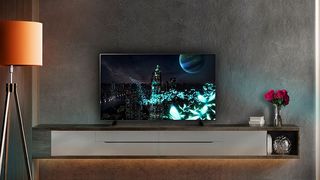
Espeficicaciones
Razones para comprar
Razones para no comprar
Si quieres el mejor televisor para juegos y una pantalla OLED espectacular, merece la pena considerar el LG C2. Toma todo lo bueno de nuestra anterior elección, el LG C1, y le añade una pantalla mucho más brillante (en todos los modelos menos en los de 42 y 48 pulgadas) con un procesamiento y una saturación del color mejorados. Puede que el C1 sea más asequible ahora que está muy rebajado, pero el C2 tiene mejores especificaciones.
Durante nuestras pruebas, nos impresionó mucho la pantalla OLED 4K, que ofrece unos niveles de negro y un rango dinámico (la diferencia entre las partes más oscuras y las más brillantes de la pantalla) realmente impresionantes, ideales tanto para jugar como para ver series. A diferencia de los televisores LCD, que se retroiluminan o se iluminan en los bordes, los píxeles OLED generan su propia luz. Esto significa que puedes tener zonas brillantes y oscuras una al lado de la otra, sin que la luz se filtre entre ellas.
A los jugadores les encantará, ya que incluye FreeSync, G-Sync y VRR estándar nada más sacarlo de la caja. Con una frecuencia de refresco nativa de 120 Hz y HDMI 2.1, los propietarios de PS5 y Xbox Serie X pueden obtener la máxima resolución y frecuencia de imagen de su nuevo hardware, mientras que los propietarios de PC de gama alta tendrán una opción sólida si deciden conectar su PC al televisor a través de HDMI. También se agradece el nuevo ajuste "Prevenir retardo de entrada", que puede configurarse para potenciar un retardo increíblemente bajo de 1,5 ms.
Cuando se trata de estar preparado para el futuro, tanto para consolas como para PC de juegos, no hay nada que lo haga mejor por el mismo precio: es el mejor televisor para jugar con Dolby Vision a 120 fps también en la Xbox Series X.
Aquí la reseña completa: LG C2
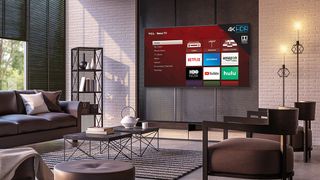
Espeficicaciones
Razones para comprar
Razones para no comprar
Si tienes un gran presupuesto, hay mejores televisores 4K en el mercado para jugar, como muchas de las pantallas mencionadas anteriormente. Pero si buscas una opción barata, después de haberte gastado mucho dinero en una consola nueva, necesitarás otra opción y, si estás en EE. UU., la serie 6 de TCL es nuestra principal recomendación económica.
Además de ser una opción económica fantástica para ver series de televisión y películas, la serie 6 de TCL es uno de los mejores televisores para juegos que puedes encontrar por debajo de los 1.000 dólares. Su rendimiento por dólar es inigualable y su calidad de imagen, a pesar de algunos defectos menores, te impresionará por lo que pagas.
Lo recomendamos especialmente para juegos, ya que tiene tres puertos HDMI 2.0 con HDCP 2.2, uno con HDMI ARC, un puerto USB 2.0, una toma de auriculares de 3,5 mm y una entrada óptica digital, además de un puerto de entrada AV que acepta la entrada compuesta estándar (RCA rojo-blanco-amarillo), ideal para juegos clásicos o dispositivos AV antiguos. Estaría bien ver otro puerto HDMI aquí, pero tres puertos HDMI deberían ser suficientes para todos, excepto para los entusiastas más ardientes de AV por ahí.
En nuestro análisis de la serie 6 de TCL escribimos: "La serie 6 de TCL es el mejor televisor de menos de 1.000 dólares, punto. Con Wide Color Gamut, Dolby Vision y un panel de matriz completa por solo 650 dólares el 55R617 de 55 pulgadas, es el televisor 4K asequible que recomendaremos a amigos, familiares y lectores". En otras palabras, si hay un televisor 4K con mejor relación calidad-precio en el mercado, aún no lo hemos visto.
Aquí la reseña completa: TCL 6-Series (R615, R617)
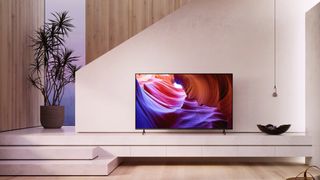
Espeficicaciones
Razones para comprar
Razones para no comprar
El Sony X90K es un televisor con una excelente relación calidad-precio. Dispone de retroiluminación LED de matriz completa con atenuación local. El resultado son unos negros profundos. Junto con los puntos cuánticos del panel LCD, el brillo y el color mejoran, aunque no es el televisor más brillante del mercado.
Este televisor es excelente para ver deportes y películas. En nuestro análisis, escribimos: "La serie X90K puede ofrecer negros profundos y detallados para ver películas, y su pico de salida de luz es lo suficientemente alto como para que también sea una buena opción para ver deportes durante el día".
Sin embargo, brilla realmente como televisor para juegos, especialmente para los poseedores de una PS5. El X90 cuenta con un fantástico conjunto de funciones para juegos, razón por la que ha entrado en esta lista en el tercer puesto de la parte superior. Aparte de la compatibilidad con vídeo 4K/120 Hz (disponible sólo en dos de las cuatro entradas HDMI del televisor), dispone de frecuencia de refresco variable (VRR) y modo de baja latencia automática (ALLM). El retardo de entrada medido por nuestro medidor de pruebas 4K fue de 13,8 ms, un resultado muy bueno.
Los televisores X90K también son perfectos para PlayStation 5. Esto significa básicamente que cuando se conecta a la consola de juegos de la compañía, se activa una función de mapeo de tonos HDR automático, junto con un modo de imagen de género automático que optimiza la imagen para los juegos.
Este es un gran televisor para juegos, especialmente por su precio, e incluso los espectadores más exigentes deberían estar satisfechos con el rendimiento que ofrece.
Aquí la reseña completa: Sony XR X90K
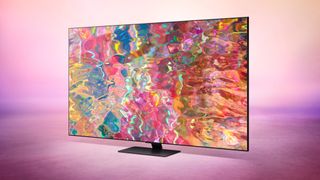
Espeficicaciones
Razones para comprar
Razones para no comprar
La Samsung Q80B es una pantalla QLED 4K de gama media de gran valor que consideramos un fantástico todoterreno, ya que es muy adecuada para ver la televisión a diario y admite juegos de alta velocidad de fotogramas.
La Q80B se sitúa justo por debajo de los modelos Mini LED Neo QLED de la marca, ofreciendo en su lugar una retroiluminación de matriz completa más convencional. Esto significa que no ofrece el rendimiento de nivel de negro o la precisión HDR de sus compañeros más caros.
Sin embargo, con cuatro entradas HDMI compatibles con HFR (alta frecuencia de imagen), una interfaz de usuario Game Bar muy útil y una interfaz doméstica inteligente pulida, sólo los cinéfilos serios se sentirán defraudados.
De hecho, la prominencia del Game Hub de Samsung, un portal a toda página de servicios de juegos en streaming, deja claro que es ahí donde reside su principal atractivo. QLED, después de todo, es inmune a las quemaduras de pantalla, lo que se traduce en sesiones de juego sin ansiedad. El Samsung también tiene cuatro HDMI que admiten reproducción 4K a 120 Hz. También es compatible con ALLM (Auto Low Latency Mode), Nvidia G-Sync y FreeSync Premium Pro para juegos.
El conjunto también tiene un sistema de sonido compatible con Dolby Atmos por encima de la media. En nuestro análisis del Samsung Q80B escribimos: "La calidad de imagen, sobre todo si se trata de una habitación luminosa, es impresionante, y el audio es lo bastante envolvente como para evitar cualquier compra adicional de una barra de sonido, al menos hasta que los fondos lo permitan."
Checa la reseña completa: Samsung Q80B
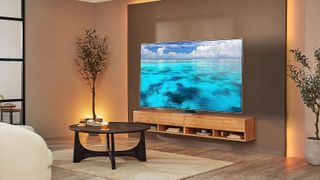
Espeficicaciones
Razones para comprar
Razones para no comprar
Si busca imágenes de calidad OLED y compatibilidad con HDMI 2.1 sin el precio asociado, permítanos presentarle el Samsung QN85B. Es una pantalla Mini-LED que ofrece un brillo increíble, tiene un retraso de entrada excepcionalmente bajo para un televisor de este tamaño y ofrece un HDR impresionante, aunque con la omisión habitual de Samsung de Dolby Vision.
Con soporte HDMI 2.1 en las cuatro entradas HDMI, compatibilidad con 4K 120Hz y soporte para ALLM, VRR y FreeSync Premium Pro, el QN85B parece equipado para sacar el máximo partido a una consola de nueva generación. Y si a eso le añadimos el brillo chispeante, el seguimiento de movimiento asegurado y la paleta de colores kilométrica de la que ya hemos hablado, así lo demuestra. En su mayor parte, al menos. El modo de juego es fantásticamente rápido, pero se pierde un poco de contraste y aumenta ligeramente el tono blanco.
Es un televisor espectacular para todo tipo de entretenimiento. El contraste es magnífico para un televisor LED, y es un panel muy brillante con una paleta de colores amplia y convincente. El procesamiento de la imagen no produce resultados extraños con CGI como algunos procesadores, y el panel IPS tiene ángulos de visión decentemente amplios. Y siempre que no veas programas muy antiguos, el upsampling es excelente.
El sonido de los televisores Samsung no siempre es el mejor, pero este es mejor que la mayoría: con cuatro altavoces y 60 W de potencia, además de la compatibilidad Q-symphony con las barras de sonido Samsung, que utiliza los altavoces del televisor como parte de un sistema de sonido envolvente más amplio, está bien. Preferiríamos un poco más de detalle en el sonido, pero solemos escucharlo a través de barras de sonido o receptores AV, así que para nosotros no es un problema.
Aquí la reseña completa Samsung QN85B
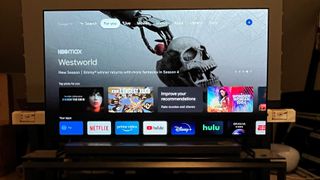
Espeficicaciones
Razones para comprar
Razones para no comprar
This is Sony's mid-range OLED TV, offering a less advanced screen than the high-end Sony A95K, but still packing in all of its best image processing and – crucially for us – gaming features.
You've got 4K 120Hz and VRR support over two HDMI 2.1 ports, with a great low latency of 12ms when we tested it. And this is part of Sony's Perfect for PS5 TV line-up, which means it includes Auto HDR Tone Mapping support with the console. This means the PS5 adjusts its HDR output to match the exact capabilities of the screen, so you always get the best-looking image.
And it's doesn't rely on its gaming features to get by. We were very impressed with the image quality in our tests, and said "The Sony A80K offers all the best things you expect from an OLED TV such as detailed blacks and well-saturated color, plus Sony’s Acoustic Surface Audio+ tech". The latter of these means that it sounds so good, you won't need to pay for a soundbar too.
It doesn't go as bright as the LG C2, or the higher-end LED and mini-LED TVs here, but it does offer an infinite contrast ratio – it's capable of 'true blacks', by which we mean we measured it at 0 nits when it was supposed to show blackness. Absolutely nothing. That's very impressive, and makes it great for atmospheric games or movies in HDR. It's a shame that it lacks HDR10+ for movies, but that's okay. There's Dolby Vision HDR support, which is the important thing.
If you've got a PS5 in particular and want an OLED that gets that absolute best out of it, this is an excellent choice.
Read the full Sony A80K review
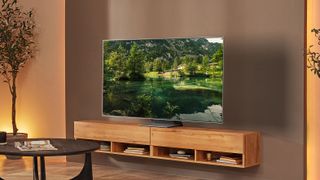
Espeficicaciones
Razones para comprar
Razones para no comprar
Samsung's QD-OLED display combines the famous self-emissive properties of OLED with the brightness and color range potential of QLED, delivering superb picture quality and exceptional brightness with better blacks and contrast than most non-OLED displays. In our review, we said that with a bit of tweaking it provides a combination of brightness, black depth, contrast and color that we just haven’t seen before on a consumer set. It's something special.
There are four HDMI ports that all support 4K at 120Hz, variable refresh rate and automatic low latency mode switching features now available to Xbox Series X, PS5 and PC gamers with the latest premium Nvidia and AMD graphics cards. These cutting edge HDMIs are backed up, too, by three USBs and Bluetooth and Wi-Fi network options. The built-in sound system is very impressive for such a slim set, with Dolby Atmos and Samsung's Object Tracking tech for positional audio.
As with pretty much all Samsung TVs these days the S95B can support the ‘standard’ HDR10 format, the live stream-friendly HLG format, and Samsung’s home-grown HDR10+ format, which adds extra scene by scene data compatible TVs can use to deliver better HDR images. Samsung continues, however, not to support the premium Dolby Vision HDR format - even though more content is available in Dolby Vision than HDR10+.
Read the full Samsung S95B OLED TV review

Espeficicaciones
Razones para comprar
Razones para no comprar
The Samsung QN95A was the company’s new flagship Neo QLED 4K TV last year, and it's the first to have a Mini LED backlight. It's a bit pricier than most models in this list – but if you have the cash, it could serve you well as a well-specified HDMI 2.1 TV for gaming.
There’s a host of cutting-edge gaming features that’ll please next-gen console owners, all of which are part of the Slim One Connect box that ships with the QN95A.
The box houses four HDMI inputs, one of which (HDMI 3) supports eARC. All of the HDMI inputs are capable of handling up to 40Gbps, which means they can accept 4K/120Hz, VRR and ALLM. While not full HDMI 2.1 connections, they offer sufficient bandwidth, making this TV a great choice for next-gen gamers who want to take full advantage of their new console.
We were very impressed with the results, which included superb standard definition video and HDR with deep, solid blacks and impressively bright highlights. Unlike standard LED TVs the mini-LED backlight delivered its visuals without obvious light bloom or loss of shadow detail, and the quantum dot technology delivers impressive saturation and colour fidelity too. We liked the sound system too: the OTS+ audio system packed into this 120Hz means you're getting some impactful 4.2.2 channel sound for your games too.
Read the full Samsung QN95A Neo QLED TV review
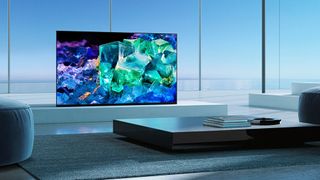
Espeficicaciones
Razones para comprar
Razones para no comprar
When we tested the Sony A95K, Sony’s flagship, next-gen QD-OLED TV, we were so impressed by the picture we wrote in our review that it delivers “arguably the most flat-out beautiful images we’ve seen from a consumer television.”
That’s no exaggeration. Thanks to a combination of its excellent Cognitive XR processor with a new Quantum Dot OLED screen, the picture quality is truly outstanding and although rivals—like the 65-inch Samsung S95B—deliver a fantastic experience, this is our top pick for picture alone.
However, we know that the best TV isn’t necessarily the best gaming TV, so how does the Sony A95K fare? Well, there’s a lot for gamers to love here, including 4K images at 120Hz frame rates and variable refresh rates. The Sony A95K also supports ‘Perfect for PlayStation 5’, exclusive features built-in to the latest Sony TVs that make using a PS5 more immersive and seamless.
For example, the console automatically optimizes its HDR game output settings based on the Sony TV it’s connected to, while the Auto Genre Picture mode is essentially a proprietary Sony version of the Auto Low Latency Mode HDMI 2.1 feature that enables TVs to switch in and out of their low-latency game picture presets automatically as a console or PC switches between game and video sources.
Unfortunately, it only has two HDMI 2.0 ports. By normal standards this is fine, but it’s weak for such a high-end TV with an eye-watering price tag. What’s more, there’s no 4K 120Hz Dolby Vision gaming mode for Xbox users, and you can’t enjoy Dolby Vision at all from any source if you don’t choose the necessary setting from the HDMI set-up menu.
The other major drawback is the price. Yes, the Sony A95K looks fantastic, but it’s more than $1000 / £1000 more expensive than several rivals at $3,999 / £3,499 / AU$5,995 for the 65-inch version.
Read the full Sony XR-A95K review
Best gaming TVs: FAQs
How to choose the best gaming TV
There are a few key things to consider when you're choosing the best gaming TV for you.
Game Mode and low latency: Latency is the time between when an image is sent by the console and when it actually shows up on the screen. Modern TVs do a lot of clever processing to images to make them look better, but this takes time, which means there's a delay between you pressing a button on a controller and seeing the result – that's not ideal in a fast-paced game. All TVs now have a Game Mode, or something with a similar name, which reduces the processing, meaning lower latency.
HDMI 2.1: The latest and greatest HDMI connector tech, which includes support for ALLM, 4K 120Hz, and VRR.
ALLM: Auto Low Latency Mode is a newer feature where consoles can tell the TV to switch into Game Mode automatically – you won't have to set it with a remote.
4K 120Hz: This means a TV can refresh its screen up to 120 times per second, while still displaying at 4K resolution. Cheaper TVs are more likely to refresh at 60 times per second. You may also find some mid-range 4K TVs that refresh at 120Hz, but don't include HDMI 2.1, so they can only show Full HD resolution at 120Hz, or 4K at 60Hz.
VRR: Variable Refresh Rate is a feature that means the TV will synchonize the speed at which is refreshes the screen with whatever the current framerate of your game is. This means games don't have to stay locked to 30, 60 or 120fps to avoid screen tearing, which means they can offering better graphics. There are three types of VRR: HDMI forum; FreeSync and G-Sync.
HDMI forum VRR: This is supported by both the PS5 and Xbox Series X, and is an official part of the HDMI 2.1 spec. Most TVs with HDMI 2.1 support it.
AMD FreeSync: This is supported by the Xbox Series X and AMD graphics cards on PC. It's pretty common to find on TVs, including on some without HDMI 2.1.
Nvidia G-Sync: This is supported by Nvidia graphics cards on PC, but not by consoles. It's pretty rare to find on TVs, too, but it does happen.
Is a TV good for PC gaming?
We've established that gaming TVs are fantastic companions for your games consoles, but what if you play on PC? There's certainly an appeal in playing graphically intensive PC games on a big screen, but how does that play out in practice?
While a gaming TV can certainly substitute for a PC gaming monitor, you'll need to make sure your PC can handle the resolution. 4K screens are naturally more taxing on your PC's resources due to them offering much higher image quality.
If your PC is up to scratch, you'll get a smooth experience at 4K on a bigger screen. If not, you may have to switch your game to a lower resolution like 1440p or 1080p, in which case your gaming TV might not be able to handle the upscaling needed very well. This will result in a blurrier than intended image thanks to the size of the TV compared to a monitor.
It's a double-edged sword, then, and almost entirely dependant on how powerful your PC is. If you've got the high-end parts to make it happen, then PC gaming on a TV can produce wonderful results. If it's not quite there, then you're better off playing on a smaller monitor able to output a sharper, cleaner image.
How much is a gaming TV?
TVs suited for gaming vary wildly in price, depending on a wide number of factors. 4K gaming TVs are incredibly common these days, and can be bought for as little as $300 / £300 / AU$450. Of course, you're getting very basic features with a TV at this price, with a size of around 43-inches and potentially lacking niceties like HDR (high dynamic range) which packs a much greater gamut of colors.
There are plenty of cheap 4K gaming TVs available, then, but those of you looking for the best experience possible might want to seek out a 4K gaming beast like the LG C1, which offers gorgeous HDR and some of the lowest input lag we've ever seen. Of course, LG's flagships don't come cheap, and you can expect to pay around $1,499 / £1,699 (around AU$2,999). And that's just for the smallest available model in each region.
Do I need an 8K gaming TV?
The short answer? No.
While 8K games are absolutely on the horizon, and the PS5 / Xbox Series X console come with this capability baked-in, there's no immediate need to get an 8K TV for gaming. Gaming devs are still getting to grips with 4K performance, and in general other picture specifications like a high frame rate (60fps, 120fps) are going to be more important in the coming years.
In 2025, maybe it'll be a different answer, but for now we think the 4K gaming TVs listed above will do you just fine.
How we test
How we test the best gaming TVs
¿Por qué puedes confiar en TechRadar?
Read the specs and marketing claims of TV makers and they often over promise on what the TV can really do. That's why we've extensively tested all of the best gaming TVs in this list to ensure they work well and deliver on their next-gen gaming specs.
What that means is we'll publish the official specs from the TV manufacturer, like the input lag or refresh rates on offer, then tell you ourselves whether the TV lived up to them in practice.
To do this, we tend to review TVs with a range of different content. Of course, next-gen gaming takes priority in this guide, but we imagine you'll also want to know what movies and TV shows are like to watch as well.
That means as well as testing for all of the key specs you need in a gaming TV, like refresh rates and HDMI connections, we're also looking for good picture quality, vibrant colors and viewing angles to suit all kinds of rooms.
Sound is less of a priority with most gaming TVs as you'll get the best experience from gaming headphones or a soundbar, but it's always good to know you'll get a decent built-in experience. Which is why we've also detailed what it was like to listen to these TVs without additional devices, too.
As we've reviewed many TVs over the years – and many of the best gaming TVs – all of our testing isn't done in isolation, but takes into account the performance and specs of every TV that's come before it.
Why should I upgrade?

You may be wondering why you need a gaming-specific television. After all, won't a regular TV do the job just fine?
Sure, any old HD or 4K TV will be able to display the picture information sent through from a games console, as long as it has an HDMI 2.0 port. But there are a host of reasons worth getting a TV with dedicated gaming specification, to really elevate your play in how it looks, sounds, and feels.
4K resolution
If you're looking for one of the best TVs for gaming, the most basic requirement is 4K. The Xbox One S outputs all of its games in 4K, which is achieved via surprisingly good built-in upscaling, though the Xbox One X is required for native, game engine-integrated 4K support. The PS4 Pro also outputs games in 4K, using a mix of upscaling and in-game enhancement – while the Nintendo Switch only outputs at HD to a TV, though there's chatter around a possible 4K refresh coming in 2021.
Frame rate handling
Now that the Xbox One X is almost here and promising native 4K resolution games running at 60 frames a second, make sure that whatever TV you buy has the latest specification HDMI sockets. If it doesn’t have at least one HDMI socket built to the v2.0a specification, it won’t be able to receive 4K resolution at anything higher than 30 frames a second.
Fortunately far more of this year’s 4K TVs do feature HDMI 2.0a sockets than in previous years, but it’s still something that’s worth double checking - especially if you’re buying a particularly cheap TV.
The new HDMI 2.1 standard will no doubt become the benchmark for high-end gaming in time, but we're yet to see it really rolled out across commercially-available sets.

High dynamic range (and high peak brightness)
Sitting right alongside 4K in today’s video world is high dynamic range (HDR) technology. This delivers pictures with a much wider light range than the standard dynamic range pictures we’ve been living with for decades in a bid to get the pictures we’re seeing on our screens looking closer to the way our eyes see the real world.
This is something the Xbox Series X has an advantage in, with an Auto HDR feature that applies some HDR magic even to SDR games that haven't been purposefully remastered for high dynamic range. The PS5, as well as last-gen consoles like the PS4 and Xbox One, though, do display in HDR in games that support the format.
The Xbox Series X also supports Dolby Vision – a dynamic HDR format with more precisely calibrated contrast – though currently only for streaming apps. You won't find it supported on the built-in 4K Blu-ray player, or actually in any Xbox Series X games – though that latter point is expected to be amended before 2021 is out.
Most people would say that HDR delivers more impact than 4K, especially on small TVs. The only problem is that HDR puts a lot of pressure on a TV, since it demands both much more brightness than SDR, and better contrast so that the extra brightness and deeper blacks can potentially share the screen simultaneously.
Many movies and games target 1,000 nits or so for their brightest elements, so if you have a TV less bright than that it won’t unlock HDR’s full potential. That's especially true in a video game environment, where graphics can be more stark in contrast terms than ‘real life’ tends to be.
Bit depth
When considering HDR, you might want to think about your gaming TV’s bit depth. too. The best HDR experience requires a 10-bit screen able to support 1024 values of each RGB colour – otherwise you'll get an inferior colour performance, including, possibly, colour striping where you should see subtle blends. Most premium HDR TVs these days are 10-bit, but it’s far from a given at the affordable end of the TV market.
Xbox and PlayStation consoles automatically assess the bit-depth of your TV and select the optimum HDR video output accordingly. Xbox models even provide a description of your TV’s capabilities under 4K TV Details in its Advanced Video Settings menu.
To be clear, it’s entirely possible for an 8-bit TV to deliver a good HDR colour performance if they have a strong video processing engine – but 10-bit panels certainly have an immediate advantage.
One other point to add here is that some TVs – including high-end Samsung models – actually support 12-bit colour management/processing, even though their panels are only natively 10-bit. Xbox consoles however do provide Colour Depth boxes in their Video Fidelity settings that let you select the maximum bit performance for your particular TV.
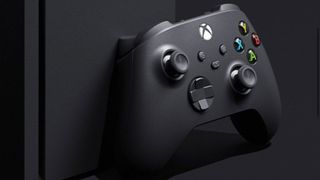
Color purity
Another advanced setting but important thing to consider for the ultimate gaming visuals is chroma subsampling.
This video compression term refers to a TV’s colour purity, and is usually written in such terms as 4:4:4 and 4:2:0. These numbers reveal how many pixels colour is sampled from in the top and bottom rows for every two rows of four pixels. So with 4:2:0, for instance, colour is being sampled from two pixels in the top row and no pixels in the bottom row.
From this it follows that the bigger the numbers are, the purer the colour performance will be, as there’s less ‘guesstimating’ of what colours should look like. The problem is, full 4:4:4 colour support requires a lot of extra image data, and so cannot be handled by the HDMI connections or processing of all TVs.
In truth, the differences in picture quality between 4:4:4 and 4:2:2 and even 4:2:0 aren’t usually enormous. They can be more pronounced with gaming graphics than video, though, so it’s worth trying to check what a TV you’re thinking of buying can support – even though it’s not information regularly carried in TV spec lists. The latest consoles are pretty good at detecting the optimum chroma subsampling a TV can support, automatically adjusting their outputs according.
It’s something that can cause annoying ‘handshaking’ issues with some TVs, though, and home consoles now tend to provide subsampling ‘limiter’ options in their video output menus (‘Enable 4:2:2’ on the Xbox One S, and 2160 YUV4:2:0 on the PS4 Pro).
Surround sound
Sound design has always played an integral part in a great gaming experience. It’s getting taken to another level these days, though, with the arrival of surround sound gaming. In fact, the Xbox Series S and Xbox Series X even support Dolby Atmos: Dolby’s most advanced sound system yet, which introduces a height channel and ‘object based’ precision to the soundstage.
Things to pay attention to are whether speakers are facing forwards (as this will almost always give you a more direct, clean sound); rated power output; whether there’s a dedicated bass speaker (often found on a TV’s rear); built-in soundbars; and the number of individual speakers used.
Sony is making much of the '3D Audio' capability of the PS5, too, so expect good TV speakers to become even more crucial when the next-gen console launches. (There's no Dolby Atmos support on the PS5, though.)
Get the best Black Friday deals direct to your inbox, plus news, reviews, and more.
Sign up to be the first to know about unmissable Black Friday deals on top tech, plus get all your favorite TechRadar content.

- Al GriffinSenior Editor Home Entertainment, US
- Michelle Rae UyContributor
- Matt BoltonManaging Editor, Entertainment